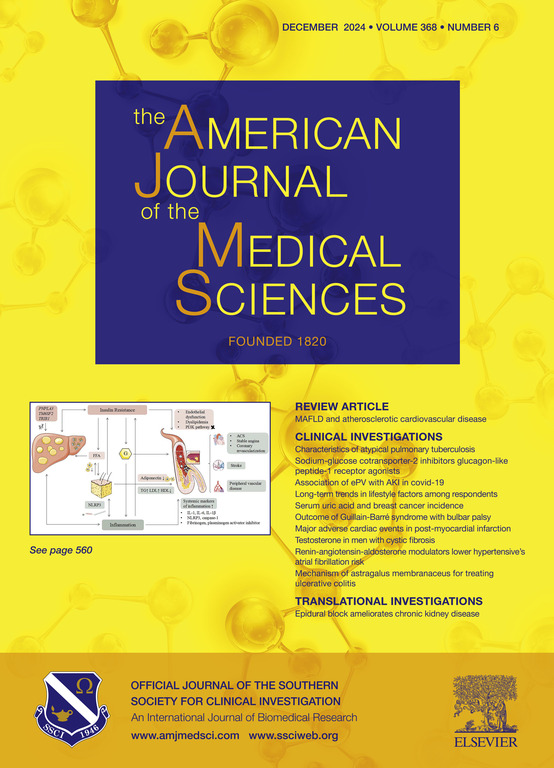Association of hepatitis B virus infection and helicobacter pylori co-infection with gastric disorders and cancer
IF 1.8
4区 医学
Q2 MEDICINE, GENERAL & INTERNAL
引用次数: 0
Abstract
Background and aims
The relationship between hepatitis B virus (HBV) and gastric disorders remains elusive. This study aimed to assess the associations between HBV infection and three gastric disorders. To our knowledge, this is among the first studies to report a synergistic association between HBV and HP co-infection and gastric cancer risk.
Methods
HBV-positive patients (n = 352) and HBV-negative controls (n = 520) were recruited from June 2018 to May 2020 at the People’s Hospital of Qijiang District. All patients were examined with gastroscopy and histopathological analysis was performed on gastric specimens. HBV DNA and hepatitis B virus surface antigen (HBsAg) were detected by qPCR and the enzyme-linked immunosorbent assay (ELISA), respectively. The relationship of HBV infection with gastric disorders was evaluated by logistic regression analysis. Survival and relapse rates of HBV gastric cancer (GC) cases were estimated using the Kaplan-Meier survival curve and Cox proportional hazard regression model.
Results
Gastric mucosal lesions were more serious in the HBV-positive group than in the HBV- negative groups (P < 0.05). HBV DNA and HBsAg levels were strongly correlated with the manifestation of gastritis, gastric ulcer, and GC, and were the highest in GC patients. HBV and Helicobacter Pylori (HP) infections were identified as risk factors for GC (P < 0.05). HBV was significantly associated with gastric ulcer (OR = 10.51, 95 % CI = 5.66–19.52, p < 0.01) and gastric cancer (OR = 2.21, 95 % CI = 1.21–3.47, p = 0.037), while co-infection with HP further increased GC risk (OR = 3.39, 95 % CI = 1.71–6.12, p < 0.01).
Conclusions
HBV infection was correlated with some gastric lesions. HBV infection alone might be a risk factor of GC. HBV infection potently increases the risk of GC in HP-positive patients.
乙型肝炎病毒感染和幽门螺杆菌合并感染与胃疾病和胃癌的关系:一项在中国人群中的研究
背景与目的:乙型肝炎病毒(HBV)与胃疾病的关系尚不明确。本研究旨在评估HBV感染与三种胃疾病之间的关系。据我们所知,这是首次报道HBV和HP合并感染与胃癌风险之间存在协同关联的研究之一。方法:于2018年6月至2020年5月在綦江区人民医院招募hbv阳性患者(n = 352)和hbv阴性对照组(n = 520)。所有患者均行胃镜检查,并对胃标本进行组织病理学分析。采用qPCR和酶联免疫吸附试验分别检测HBV DNA和乙型肝炎病毒表面抗原(HBsAg)。采用logistic回归分析评价HBV感染与胃功能障碍的关系。采用Kaplan-Meier生存曲线和Cox比例风险回归模型估计HBV胃癌(GC)病例的生存率和复发率。结果:HBV阳性组胃粘膜病变严重程度高于HBV阴性组(P < 0.05)。HBV DNA和HBsAg水平与胃炎、胃溃疡和胃癌的表现密切相关,以胃癌患者最高。HBV和幽门螺杆菌(HP)感染是GC的危险因素(P < 0.05)。乙型肝炎病毒与胃溃疡显著相关(或 = 10.51,95% CI = 5.66 - -19.52,p < 0.01)和胃癌(或 = 2.21,95% CI = 1.21 - -3.47,p = 0.037),而惠普合并感染风险进一步增加GC(或 = 3.39,95% CI = 1.71 - -6.12,p < 0.01)。结论:HBV感染与部分胃病变相关。HBV感染本身可能是胃癌的危险因素。HBV感染可能增加hp阳性患者发生GC的风险。
本文章由计算机程序翻译,如有差异,请以英文原文为准。
求助全文
约1分钟内获得全文
求助全文
来源期刊
CiteScore
4.40
自引率
0.00%
发文量
303
审稿时长
1.5 months
期刊介绍:
The American Journal of The Medical Sciences (AJMS), founded in 1820, is the 2nd oldest medical journal in the United States. The AJMS is the official journal of the Southern Society for Clinical Investigation (SSCI). The SSCI is dedicated to the advancement of medical research and the exchange of knowledge, information and ideas. Its members are committed to mentoring future generations of medical investigators and promoting careers in academic medicine. The AJMS publishes, on a monthly basis, peer-reviewed articles in the field of internal medicine and its subspecialties, which include:
Original clinical and basic science investigations
Review articles
Online Images in the Medical Sciences
Special Features Include:
Patient-Centered Focused Reviews
History of Medicine
The Science of Medical Education.

 求助内容:
求助内容: 应助结果提醒方式:
应助结果提醒方式:


